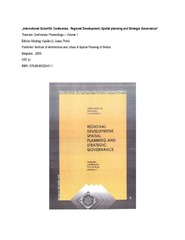Transformation of rural settlemetns and rural housing improvement in Serbia
Апстракт
Rural settlements in Serbia are in a crisis on many bases: decrease in the number of population, with age structure changes, loss of identity, lack of organization, poor public transport infrastructure and accessibility, small amount of investments in the development due to the lack of planning regulation and development programs. Depending on the area, the village needs to undergo transformation in a number of segments: diversification of the land holding size starting from the large agricultural combines through the medium-sized and in the end small producers; restructuring the network of rural settlements; development of smaller production capacities associated in systems; renewal of the cooperation in the areas with fragmented land holdings; realization of the communal order and equipment; improvement of the production technology along with the expected reduction in the number of inhabitants. The key is to accept that the village has to undergo significant transformation in all seg...ments in order to become comfortable enough for dwelling both in terms of individual households and in terms of satisfying the social and collective needs of the community. The methods should be aimed at long-term plan action with the aim of balancing living standards and achieving direct communication village-city. In this paper, the regional specificities within Serbia and in Serbia as a whole are analyzed, recognizing the development trends and the need for change in the development of rural settlements.
Кључне речи:
transformation / development / planning / rural areaИзвор:
Regional development, spatial planning and strategic governance. Thematic Conference Proceedings, 2009, 1, 179-195Издавач:
- Belgrade : Institute of Architecture and Urban & Spatial Planning of Serbia
Финансирање / пројекти:
- Одрживи развој и уређење бањских и туристичких насеља у Србији (RS-MESTD-MPN2006-2010-16007)
Напомена:
- Editors: Miodrag Vujošević, Jasna Petrić
Група
RAUmPlanTY - CONF AU - Marić, Igor AU - Bogdanov, Ana AU - Manić, Božidar PY - 2009 UR - https://raumplan.iaus.ac.rs/handle/123456789/373 AB - Rural settlements in Serbia are in a crisis on many bases: decrease in the number of population, with age structure changes, loss of identity, lack of organization, poor public transport infrastructure and accessibility, small amount of investments in the development due to the lack of planning regulation and development programs. Depending on the area, the village needs to undergo transformation in a number of segments: diversification of the land holding size starting from the large agricultural combines through the medium-sized and in the end small producers; restructuring the network of rural settlements; development of smaller production capacities associated in systems; renewal of the cooperation in the areas with fragmented land holdings; realization of the communal order and equipment; improvement of the production technology along with the expected reduction in the number of inhabitants. The key is to accept that the village has to undergo significant transformation in all segments in order to become comfortable enough for dwelling both in terms of individual households and in terms of satisfying the social and collective needs of the community. The methods should be aimed at long-term plan action with the aim of balancing living standards and achieving direct communication village-city. In this paper, the regional specificities within Serbia and in Serbia as a whole are analyzed, recognizing the development trends and the need for change in the development of rural settlements. PB - Belgrade : Institute of Architecture and Urban & Spatial Planning of Serbia C3 - Regional development, spatial planning and strategic governance. Thematic Conference Proceedings T1 - Transformation of rural settlemetns and rural housing improvement in Serbia VL - 1 SP - 179 EP - 195 UR - https://hdl.handle.net/21.15107/rcub_raumplan_373 ER -
@conference{
author = "Marić, Igor and Bogdanov, Ana and Manić, Božidar",
year = "2009",
abstract = "Rural settlements in Serbia are in a crisis on many bases: decrease in the number of population, with age structure changes, loss of identity, lack of organization, poor public transport infrastructure and accessibility, small amount of investments in the development due to the lack of planning regulation and development programs. Depending on the area, the village needs to undergo transformation in a number of segments: diversification of the land holding size starting from the large agricultural combines through the medium-sized and in the end small producers; restructuring the network of rural settlements; development of smaller production capacities associated in systems; renewal of the cooperation in the areas with fragmented land holdings; realization of the communal order and equipment; improvement of the production technology along with the expected reduction in the number of inhabitants. The key is to accept that the village has to undergo significant transformation in all segments in order to become comfortable enough for dwelling both in terms of individual households and in terms of satisfying the social and collective needs of the community. The methods should be aimed at long-term plan action with the aim of balancing living standards and achieving direct communication village-city. In this paper, the regional specificities within Serbia and in Serbia as a whole are analyzed, recognizing the development trends and the need for change in the development of rural settlements.",
publisher = "Belgrade : Institute of Architecture and Urban & Spatial Planning of Serbia",
journal = "Regional development, spatial planning and strategic governance. Thematic Conference Proceedings",
title = "Transformation of rural settlemetns and rural housing improvement in Serbia",
volume = "1",
pages = "179-195",
url = "https://hdl.handle.net/21.15107/rcub_raumplan_373"
}
Marić, I., Bogdanov, A.,& Manić, B.. (2009). Transformation of rural settlemetns and rural housing improvement in Serbia. in Regional development, spatial planning and strategic governance. Thematic Conference Proceedings Belgrade : Institute of Architecture and Urban & Spatial Planning of Serbia., 1, 179-195. https://hdl.handle.net/21.15107/rcub_raumplan_373
Marić I, Bogdanov A, Manić B. Transformation of rural settlemetns and rural housing improvement in Serbia. in Regional development, spatial planning and strategic governance. Thematic Conference Proceedings. 2009;1:179-195. https://hdl.handle.net/21.15107/rcub_raumplan_373 .
Marić, Igor, Bogdanov, Ana, Manić, Božidar, "Transformation of rural settlemetns and rural housing improvement in Serbia" in Regional development, spatial planning and strategic governance. Thematic Conference Proceedings, 1 (2009):179-195, https://hdl.handle.net/21.15107/rcub_raumplan_373 .



